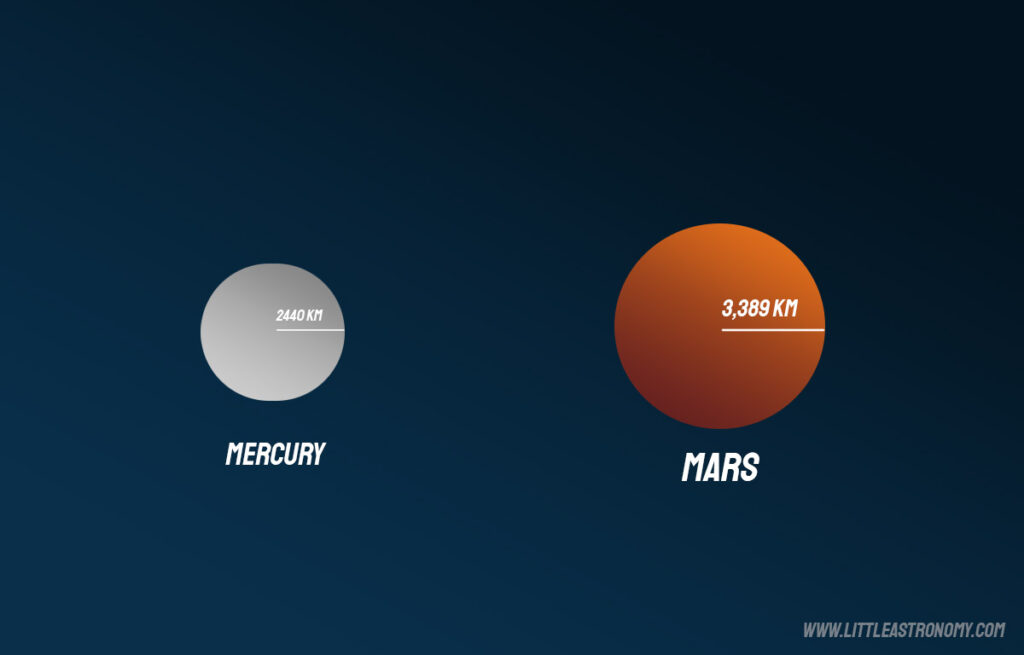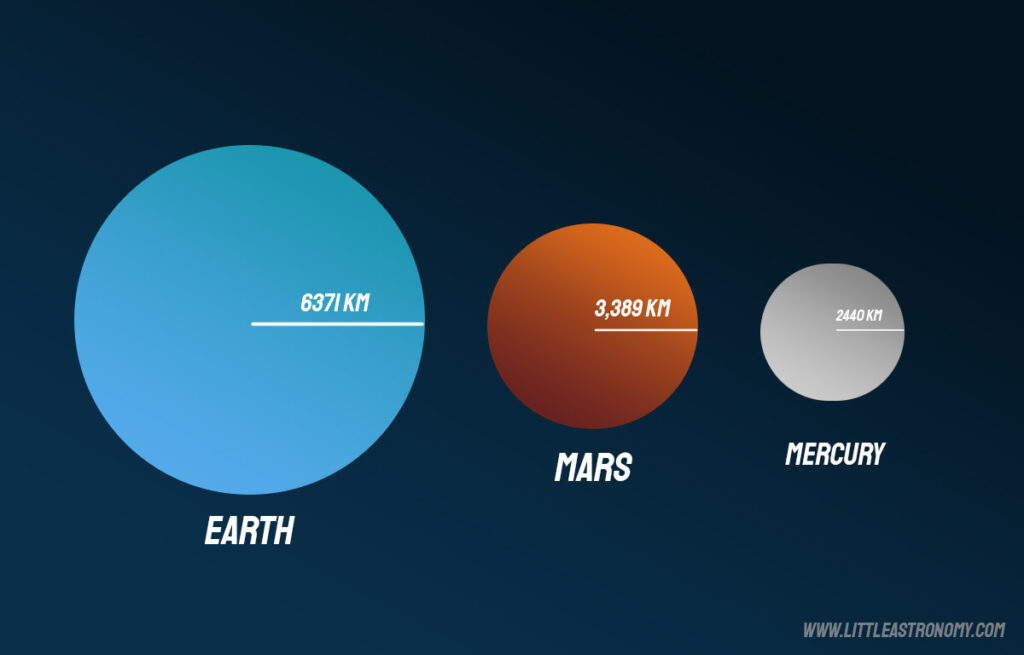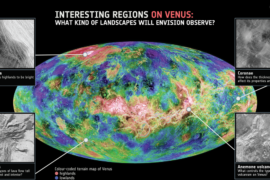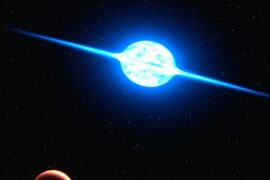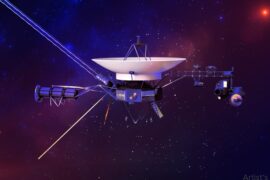It might be hard to notice just by looking at them, but Mercury and Mars share many things in common despite being more than 172 million kilometers apart from each other (107 million miles).
As a matter of fact, all the rocky planets of the Solar system (Mercury, Venus, Earth, and Mars) have many similarities. For starters, they formed at more or less the same time and from the same protoplanetary disc (the cloud of dust and gas that formed around the Sun after its formation).
Still, Mercury and Mars have evolved in different paths throughout the 4.6 billion years of their existence. In this article, we’ll compare these two planets and analyze their differences and similarities.
Mercury vs Mars comparison
| Mercury | Mars | |
|---|---|---|
| Position in the Solar system | 1 | 4 |
| Distance from the Sun (avg) | 58 million km | 226 million km |
| Radius | 2,440 km | 3,389 km |
| Mass | 3.3×1023 kg | 6.4171×1023 kg |
| Rotation period (1 day) | 59 days | 24 hours 37 minutes (1.025 days) |
| Orbit period (1 year) | 87.9 days | 687 days |
| Orbital speed | 47.36 km/s | 24.07 km/s |
| Surface temperature (avg) | 164 °C | −110 °C to 35 °C |
| Surface pressure | almost zero (< 0.5 nPa) | 0.636 kPa |
| Surface gravity | 3.7 m/s2 | 3.72 m/s2 |
| Density | 5.43 g/cm3 | 3.93 g/cm3 |
| Escape Velocity | 4.25 km/s | 5.027 km/s |
| Albedo | 0.088 | 0.170 |
| Satellites (Moons) | 0 | 2 |
| Core | rock | rock |
| Atmosphere | 42% O, 29% Na, 22% H, 6% He | 95% CO2, 2.6% N2, 1.9% Ar, 0.16% O2, 0.06% CO |
Mercury and Mars size comparison
The following image shows a scaled comparison of the size of Mercury vs Mars. And the one below shows Earth for reference.
Mercury and Mars similarities
- Both planets orbit around the Sun
- Scientists believe they both formed around the same time, 4.6 billion years ago.
- The cores of Mercury and Mars have similar compositions. They are both solid, rocky cores made out of silicate materials, iron, nickel, and other metals.
- Both planets have a rocky, solid surface. If that seems a bit obvious, remember that only half the planets in the Solar system have a surface.
- The atmospheres of both planets are very thin. They both lost it due to Solar winds and radiation.
- The gravity of both planets is lesser than Earth’s
- Both planets were known to ancient civilizations as they can be seen with the naked eye from Earth.
- Both planets get their names from the Roman equivalent of Greek deities. Mercury is named after the god of travel and communication, and Mars is named after the god of war.
- Both planets are outside the Solar system’s habitable zone, which is the area where a planet can support liquid water (like Earth)
- Mars and Mercury have very few clouds, this is why from Earth we can see the Martian surface with clarity (Mercury is a bit harder because of the distance and its closeness to the Sun).
- Neither planet are very reflective because of their thin atmospheres. We can only see them because they are so close (in astronomical terms) to Earth.
- Both planets rotate in the same direction (counter-clockwise)
- Both planets have ice. Mars in its poles and Mercury on the side of the planet that doesn’t get sunlight as it rotates.
- Both planets are uninhabitable for humans.
Mercury and Mars differences
- Mars has two moons (natural satellites) called Phobos and Deimos. Mercury doesn’t have any.
- Mercury is extremely hot. Its mean surface temperature is 333°F (167°C). On the other hand, despite its desertic appearance, Mars is very cold, its mean temperature is -85°F (-65°C).
- Despite its weak magnetic field, Mercury still has a magnetosphere (an area where the magnetic field protects the planet). Mars’ lost its magnetosphere a long time ago.
- Mars moves five times faster than Mercury through its orbit (and they both move way faster than Earth).
- Mercury rotates very slowly. One Mercurian day takes 59 Earth days. This means that a year in Mercury consists of only one and a half days. Mars on the other hand has a similar rotation speed to Earth and its days are about 24.6 hours long.
- Mars’ surface is red, Mercury’s is grey. This is because the Martian surface has many iron rocks that oxidized and turned reddish. Mercury’s surface has many rocks made of carbon-rich materials instead.
- Mercury’s core is huge in relation to the size of the planet. It makes up about 42% of the mass of Mercury while the Martian core only makes up about 17% of its planet.
- The surface of Mercury is covered in craters, almost like the Moon. The surface of Mars is not. That is because while Mars has also been hit by many impacts, the craters have been hidden by geological activity and dust storms.
- Mars is almost exactly 4 times farther away from the Sun than Mercury.
- It is very likely Mars could have had liquid water on its surface at some point in its history. Mercury is unlikely to have ever had any.
- Mercury’s orbit is more eccentric (elliptical). It is actually the planet with the most eccentric orbit. Mars’ orbit is almost circular in shape.
Summary
- Mars and Mercury, like all the other planets in the Solar system, were created at the same time, 4.6 billion years ago.
- Both planets share many similarities. For example, their thin atmosphere, the composition of their core, that they both have solid, rocky surfaces, and the direction in which they rotate.
- They also have many differences. For example, The speed at which they rotate, their temperatures, color, and number of moons.
Enjoyed this article?
Get daily 10-minute PDFs about astronomy to read before bed!
Sign up for our upcoming micro-learning service where you will learn something new about space and beyond every day while winding down.


